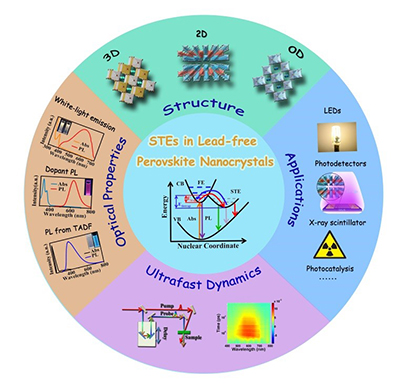Lead-free perovskite nanocrystals (NCs) with low toxicity and high stability are promising for light-emitting diode (LED) applications.
These lead-free perovskite NCs exhibit prominent excitonic effect.
Different from free excitons in lead-perovskite NCs, the self-trapped excitons (STEs) are widely observed in lead-free perovskite NCs.
Recently, a research team led by HAN Keli from the Dalian Institute of Chemical Physics (DICP) of the Chinese Academy of Sciences (CAS) published a Perspective paper about ultrafast dynamics of self-trapped excitons (STEs) in lead-free perovskite NCs.
This Perspective was published in J. Phys. Chem. Lett. on August 23.

Ultrafast dynamics of self-trapped excitons in lead-free perovskite nanocrystals (Image by YANG Bin)
STEs-based photoluminescence (PL) is always observed in these lead-free perovskite NCs. However, due to strong carrier-phonon coupling, most of the initially reported lead-free perovskite NCs exhibit "dark" STEs, that is, the STEs give no emission at room temperature.
The researchers summarized the effects of the carrier–phonon coupling strength on the photoluminescence (PL) properties of STEs. Indirect bandgap NCs exhibited much stronger carrier–phonon coupling in comparison to the direct bandgap NCs, which resulted in an ultrafast nonradiative transitions of STEs.
They presented the exciton energy transfer mediated by STEs to provide an efficient thermally activated delayed fluorescence and dopant PL, and illustrated the promising directions for future applications based on STEs.
"We hope that this work can provide a new viewpoint for researchers to understand the ultrafast dynamics of STEs and promote lead-free perovskite NCs for optoelectronic applications," said Prof. HAN.
This work was supported by the key research project of National Natural Science Foundation. (Text by YANG Bin)